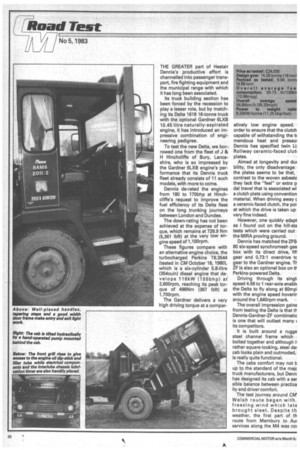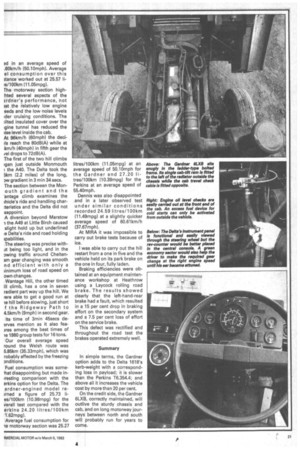THE GREATER part of Hestair Dennis's productive effort is channelled
Page 22

Page 23

If you've noticed an error in this article please click here to report it so we can fix it.
into passenger transport, fire fighting equipment and the municipal range with which it has long been associated.
Its truck building section has been forced by the recession to play a lesser role, but by matching its Delta 1618 16-tonne truck with the optional Gardner 6LXB 10.45 litre naturally-aspirated engine, it has introduced an impressive combination of engineering pedigree.
To test the new Delta, we borrowed one from the fleet of J & H Hinchcliffe of Bury, Lancashire, who is so impressed by the Gardner 6LXB engine's performance that its Dennis truck fleet already consists of 11 such models, with more to come.
Dennis de-rated the engines from 180 to 170bhp at Hinchcliffe's request to improve the fuel efficiency of its Delta fleet on the long trunking journeys between London and Dundee.
The down-rating has not been achieved at the expense of torque, which remains at 726.9 Nm (5,361 Ibft) at the very low engine speed of 1,100rpm.
These figures compare with an alternative engine choice, the turbocharged Perkins T6.3544 (tested in CM October 18, 1980), which is a six-cylinder 5.8-litre (354cuin) diesel engine that develops 116kW (155bhp) at 2,600rpm, reaching its peak torque of 498Nm (367 Ibft) at 1,70Orpm.
The Gardner delivers a very high driving torque at a compar atively low engine speed. order to ensure that the clutch capable of withstanding the tr mendous heat and pressui Dennis has specified twin Li' Rollway ceramic-faced club plates.
Aimed at longevity and dui bility, the only disadvantage the plates seems to be that, contrast to the woven asbesto they lack the "feel" or extra p dal travel that is associated wi. a clutch plate using convention material. When driving away c a ceramic-faced clutch, the poi at which the drive is taken up very fine indeed.
However, one quickly adapt as I found out on the hill-sta tests which were carried out the MIRA proving ground.
Dennis has matched the ZFS 80 six-speed synchromesh gea box with its direct drive, fifi gear and 0.73:1 overdrive tc gear to the Gardner engine. -1-1ZF is also an optional box on It Perkins-powered Delta.
Driving through its singli speed 4.56 to 1 rear-axle enablE the Delta to fly along at 60mpl with the engine speed hoverin around the 1,640rpm mark.
The overall impression gaine from testing the Delta is that th Dennis-Gardner-ZF combinatio is one that will outlast many ( its competitors.
It is built around a rugge steel channel frame which bolted together and although ii rather square-looking, steel da) cab looks plain and outmoded, is really quite functional.
The cabs comfort may not b up to the standard of the majc truck manufacturers, but Denni has designed its cab with a ser sible balance between practica ity and driver comfort.
The test journey around CM' Welsh route began with freezing wind which late brought sleet. Despite th weather, the first part of th route from Membury to Au; services along the M4 was co% ed in an average speed of .60km/h (50.10mph). Average el consumption over this Aance worked out at 25.57 liis/100km (11.05mpg).
The motorway section highhted several aspects of the irdner's performance, not 1st the ?elatively low engine eeds and the low noise levels Ider cruising conditions. The lilted insulated cover over the gine tunnel has reduced the lise level inside the cab.
At 96km/h (60mph) the deciils reach the 80dB(A) while at km/h (40mph) in fifth gear the lel drops to 72dB(A).
The first of the two hill climbs igan just outside Monmouth the A40. The Delta took the 5km (2.2 miles) of the long, aw gradient in 3 min 34 secs. The section between the Monouth gradient and the antage climb examines the thicle's ride and handling char:teristics and the Delta did not sappoint.
A diversion beyond Marstow 1 the A49 at Little Birch caused slight hold up but underlined le Delta's ride and road holding ipabilities.
The steering was precise withit being too light, and in the awing traffic around Cheltenam gear changing was smooth nd efficient with only a linimum loss of road speed on own changes.
Wantage Hill, the other timed ill climb, has a one in seven radient part way up the hill. We fere able to get a good run at le hill before slowing, just short f the Ridgeway Path to 4.5km/h (9mph) in second gear. Its time of 3min 45secs deerves mention as it also feaires among the best times of le 1980 group tests for 16 tons. Our overall average speed round the Welsh route was 5.85km (35.33mph), which was robably affected by the freezing anditions.
Fuel consumption was somehat disappointing but made in;resting comparison with the erkins option for the Delta. The ardner-engined model rered a figure of 25.73 lies/100km (10.98mpg) for the verall test compared with the erkins 24.20 litres/100km 1.62mpg).
Average fuel consumption for le motorway section was 25.27 litres/100km (11.05mpg) at an average speed of 50.10mph for the Gardner and 27.20 litres/100km (10.39mpg) for the Perkins at an average speed of 55.40mph.
Dennis was also disappointed and in a later observed test under similar conditions recorded 24.59 litres/100km (11.49mpg) at a slightly quicker average speed of 60.61km/h (37.67mph).
At MIRA it was impossible to carry out brake tests because of ice.
I was able to carry out the hill restart from a one in five and the vehicle held on its park brake on the one in four, fully laden.
Braking efficiencies were obtained at an equipment maintenance workshop at Heathrow using a Laycock rolling road brake. The results showed clearly that the left-hand-rear brake had a fault, which resulted in a 15 per cent drop in braking effort on the secondary system and a 7.5 per cent loss of effort on the service brake.
This defect was rectified and throughout the road test the brakes operated extremely well.
Summary In simple terms, the Gardner option adds to the Delta 1618's kerb-weight with a corresponding loss in payload; it is slower than the Perkins T6.354.4; and above all it increases the vehicle 'cost by more than 20 per cent.
On the credit side, the Gardner 6LXB, correctly maintained, will outlive the sturdy chassis and cab, and on long motorway journeys between north and south will probably run for years to come.












































































































